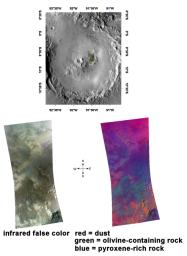This image of the interior of Oudemans Crater was taken by the Compact Reconnaissance Imaging Spectrometer for Mars (CRISM) at 1800 UTC (1:00 p.m. EDT) on October 2, 2006, near 9.8 degrees south latitude, 268.5 degrees east longitude. CRISM's image was taken in 544 colors covering 0.36-3.92 micrometers, and shows features as small as 20 meters (66 feet) across.
Oudemans Crater is located at the extreme western end of Valles Marineris in the Sinai Planum region of Mars. The crater measures some 124 kilometers (77 miles) across and sports a large central peak.
Complex craters like Oudemans are formed when an object, such as an asteroid or comet, impacts the planet. The size, speed and angle at which the object hits all determine the type of crater that forms. The initial impact creates a bowl-shaped crater and flings material (known as ejecta) out in all directions along and beyond the margins of the bowl forming an ejecta blanket. As the initial crater cavity succumbs to gravity, it rebounds to form a central peak while material along the bowl’s rim slumps back into the crater forming terraces along the inner wall. If the force of the impact is strong enough, a central peak forms and begins to collapse back into the crater basin, forming a central peak ring.
The uppermost image in the montage above shows the location of CRISM data on a mosaic taken by the Mars Odyssey spacecraft’s Thermal Emission Imaging System (THEMIS). The CRISM data was taken inside the crater, on the northeast slope of the central peak.
The lower left image is an infrared false-color image that reveals several distinctive deposits. The center of the image holds a ruddy-brown deposit that appears to correlates with a ridge running southwest to northeast. Lighter, buff-colored deposits occupy low areas interspersed within the ruddy-brown deposit. The southeast corner holds small hills that form part of the central peak complex.
The lower right image shows spectral indicators of different materials, and reveals the composition of the crater floor and its central peak. Rocks rich in the volcanic mineral pyroxene, shown in blue, dominate the north-central part of the image. There is an enhanced content of the volcanic mineral olivine (shown in greens and yellows) in those parts of the images that appear ruddy brown in false color. The low-lying parts of the image that appear buff in false color are covered in dust, and shown in red. This view provides insight into the relationships of deposits beneath Oudemans Crater. The impact excavated the underlying olivine that that is enriched in the crater’s central peak. Pyroxene-rich material covered the crater's floor, and later, low-lying areas filled with dust.
CRISM is one of six science instruments on NASA's Mars Reconnaissance Orbiter. Led by The Johns Hopkins University Applied Physics Laboratory, Laurel, Md., the CRISM team includes expertise from universities, government agencies and small businesses in the United States and abroad. NASA's Jet Propulsion Laboratory, a division of the California Institute of Technology in Pasadena, manages the Mars Reconnaissance Orbiter and the Mars Science Laboratory for NASA's Science Mission Directorate, Washington. Lockheed Martin Space Systems, Denver, built the orbiter.

 Planetary Data System
Planetary Data System












